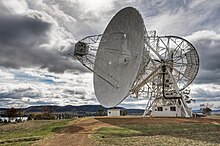Radio wave

Radio waves , including radio waves , or Hertzian waves are defined in Article 1.15 of the Implementing Regulations for the Radio Service (VO Funk) of the International Telecommunication Union (ITU) as " electromagnetic waves whose frequencies are, as agreed, below 3000 GHz , and which move in free space without artificial guidance spread."
This includes, on the one hand, the frequency ranges used for broadcasting: long wave (from 30 kHz), medium wave , short wave and ultra short wave (up to 300 MHz). The definition of VO radio also includes the radar and microwave ranges towards shorter wavelengths .
Radio waves can be of natural or technical origin. Their frequency is well outside the range in which the eye is sensitive. They are therefore invisible.
history
The existence of radio waves was predicted from theoretical considerations by James Clerk Maxwell . In 1887 they were proven experimentally by Heinrich Hertz .
The designations radio waves and broadcast radio back that first transmission experiments using spark discharge were made on high voltage generators.
Technical radio waves
The technically used frequencies of the electromagnetic spectrum range from longitudinal waves to terahertz radiation . Their technical use is regulated in internationally agreed frequency bands .
Radio waves are used for the wireless transmission of voice , images and other data such as time signals, for radio , for localization or terrain scanning ( radar ) and navigation ( GPS , radio direction finding ).
When the message is transmitted, the information to be transmitted is impressed on a carrier frequency by modulation and emitted as a wave by the transmitting antenna . The radio waves induce similar high-frequency signals in the receiving antenna , from which the information is demodulated again after prior amplification . Only because of the possibility of transmitting similar messages independently of one another with transmitters of different carrier frequencies, one can choose from the large selection of radio and television programs broadcast at the same time. According to the same basic principle, it is also possible to transmit a few hundred telephone calls on a single wire or several programs on cable television simultaneously and without mutual interference. The desired frequencies are selected using resonant circuits or digital filtering (see also digital signal processor , DSP for short).
Radio waves are also used for heating (e.g. drying, hardening, therapeutic purposes such as diathermy , or in microwave ovens ) by using the heat generated during absorption.
Terahertz radiation is used in a similar way to X-ray radiation for " fluoroscopy " (detection of otherwise invisible structures inside bodies), but is limited to non-metallic bodies.
Occurrence in nature
The earth's atmosphere is a source of radio waves. One reason for this is the temperature of the atmosphere itself, which causes radio waves with a thermal spectrum. Another source are electron transitions from molecules in the air, which z. B. be thermally or optically excited and return to the basic state with the emission of radio waves, these are mostly found in the microwave band. Lightning generates strong, transient radio waves that can be used to locate them. You are a cause of sferics . All of these radio waves are summarized as atmospheric disturbances . They contribute to the electromagnetic noise from receivers .
Many celestial bodies send out radio waves as radio sources ; these are the subject of research in radio astronomy . The sun is the most powerful extraterrestrial radio source from Earth; thermal and nonthermal radio emissions from the planets are also studied, e.g. B. the electromagnetic storms of Jupiter. The radiation of free hydrogen in the Milky Way at a wavelength of 21 cm gives u. a. Shed light on the structure of the galactic spiral arms. Other significant extraterrestrial radio sources include cosmic background radiation , supernova remnants and pulsars , quasars , radio galaxies and active galaxy nuclei .
literature
- John Fielding: Amateur Radio Astronomy . Potters Bar, England: Radio Society of Great Britain, 2006, ISBN 1-905086-16-4 .
Web links
Individual evidence
- ↑ VO Funk, Edition 2012, Article 1.5, Definition: Radio waves or hertzian waves / radio waves or Hertzian waves . PDF
- ↑ Spectrum - radio waves - page at LEIFIphysik (accessed on: July 3, 2012).
